
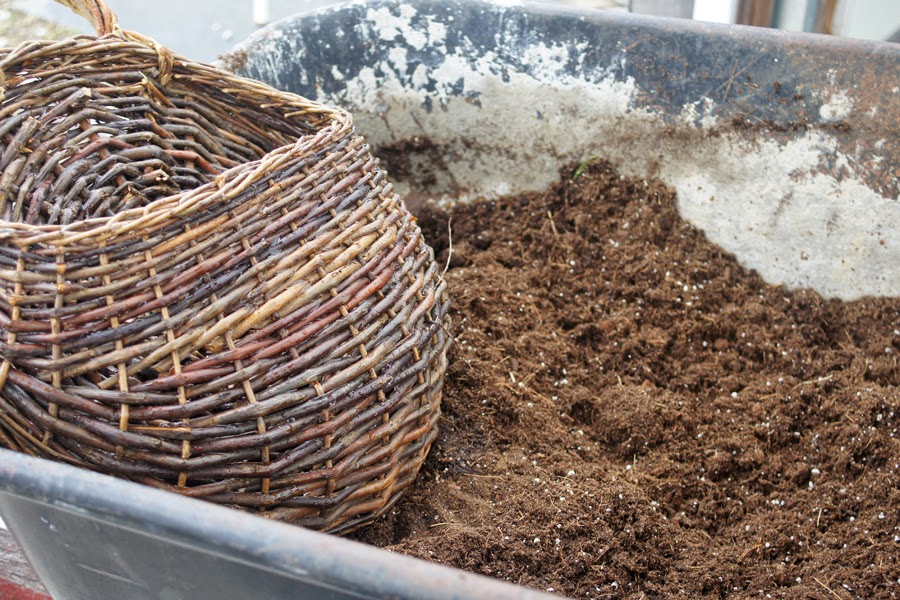












Garden Planning for the Seasonal Kitchen
Growing vegetables in your backyard, community garden or in some containers by the kitchen door is a great way to feed yourself -- whether it be just a few ripe tomatoes in August or a full-fledged homesteader's garden, you are on the right path to feeding yourself and your family. Gardening is a great way to improve how you eat while spending some contemplative time outside. With all of these benefits in mind, it is easy to jump into gardening enthusiastically, and you will reap even more rewards with a little bit of planning.
In Vermont, our gardening season seems short but can be stretched almost year round with a few simple tips. I always recommend that people take a look at how their vegetable gardens have been in the past and find just one or two things they would like to improve so that they can grow more of it for a longer season. For example a common question I hear is "how can I keep cilantro from bolting?" Well, in short, you can't! But with a few changes in your gardening practices, you can grow it all spring, summer, and fall without ever seeing it go to seed. The trick is to understand the life cycle of each vegetable or herb and how to best plant it to maximize it's harvest. With certain crops, like zucchini, it is best to understand how prolific they are and to plant them conservatively so that the entire garden (and thereby your diet and your neighbors' diet) is not taken over with just one thing. It is also helpful to plant things seasonally so that the harvest is not so overwhelming in August with little to eat before or after. Or sometimes we just want fresh salads all summer, but don't replant and are left salad-less after July 1st.
Succession Planting for Successful Gardening
Certain crops should be planted multiple times throughout the season to ensure a continuous harvest. This is called succession planting. How often you plant is a matter of taste and space and time. The following list describes the maximum you could do with each crop, but adjust according to your needs and priorities -- this is just a guide. If you want to make sure you have a certain vegetable all summer long, then you can follow the guidelines. If you want it a little less, then create your own modified planting schedule.
Planting Guide
Lettuce can be grown from seed or from transplants. Seed grown lettuce is often grown in a row that can be cut and will re- grow a few times - think of mesclun. Transplanted lettuce can be grown to produce full heads like what you find in the store. Both methods require regular planting every week or two for a continuous harvest.
Some people will transplant a few plants and plant some seeds at the same time in a different area; this method provides two generations of lettuce and two types of salad greens. Once the cut lettuce becomes bitter in the heat of summer, it is best to pull it up, recondition the soil with compost, and plant something else. If the goal is to always have fresh lettuce, it is very simple to do if you remember to replant it. You can even purchase a number of plants and hold some in their pots in a shady spot and only plant out a few each week. You can seed it yourself in trays or pots and follow this same method. Having several varieties, cold-tolerant ones for spring and fall plantings, and heat-tolerant ones for mid-summer, will produce the best flavor.
Cilantro is very similar to lettuce in its growing habits. It will grow up to a point and then goes to seed, called bolting. It will bolt more quickly in summer heat and, conversely, will stand ready to harvest for many weeks in the cool weather of fall--even early winter. It is good to time plantings so that cilantro is ready to harvest before June 21 (the solstice), and then plant more afterward. It can be transplanted or grown from seed. Like lettuce, it is simple to do both at the same time, thereby giving the gardener two generations. Cilantro seed is coriander, so it does have a use if you enjoy that flavor. There is nothing you can do to prevent cilantro from bolting entirely, but you can slow the process down by placing your mid-summer plantings in a partly-shady spot.
Dill can be treated just like cilantro, and, like coriander seed, dill seed heads have a use in the kitchen, so it is fine to let some of the dill patch go to seed. The seed heads can be used in pickles. you can also let them self-sow or save the fully dried seeds in a paper bag for replanting.
Basil can be planted multiple times for best results. Plants can be pinched to slow down the flowering, but best flavor will come from newly replanted basil plants. This is a heat loving plant. Should only be planted once soil temps are in the upper 50's - usually last week in May or first week in June. Basil's flavor is at its peak right before it starts to make flowers.
Cucumbers, cantaloupes, and zucchini and summer squash are best in quality when well tended.Just a single plant or two of any of those is usually enough for the home gardener, but by planting it two to three different times, the quality will always be good.
This method will ensure a continuous harvest of prime looking vegetables. Just remember to pull out and discard the pest- and disease- prone older plants. If your compost gets very hot and is well managed, it is okay to compost these plants. Pest problems will diminish when the older, less healthy plants are removed.
Arugula, Cress, and other cutting greens for saladsare best if sown or transplanted on a weekly or biweekly basis. Again, a small amount can be seeded next to the transplanted crops in order to give you 2 generations at once. This way you can have smaller quantities coming in at various times.
Broccoli gives the gardener a couple of options.
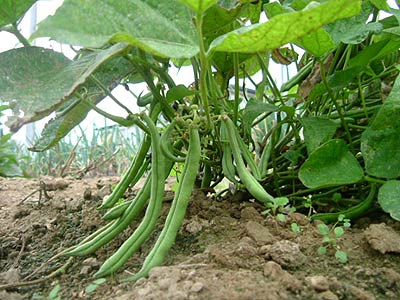
Green Beans are best when fresh and young. The seed is relatively cheap, so it is better to rip out old plants and have new ones coming along regularly. Having smaller, multiple plantings also means that no on is stuck picking beans for hours on end. Sow new seeds when the previous or first generation is about 6 inches high.
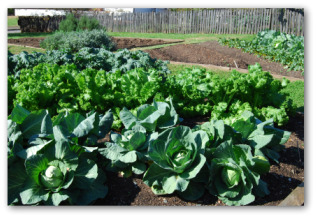
Boc Choi, Cabbage, Scallions, and Cauliflower can also be planted multiple times. Cabbage holds well in the heat and

Spinach is another one that does not do well in the heat, but can be planted multiple times in spring and late summer. It can also overwinter with a little straw mulch for very early spring eating.
Apply straw mulch on overwintering spinach in December once the ground is frozen.
Beets, Carrots, Turnipscan be planted every two or three weeks from mid-April until about the third week in July. Summer carrots are not the same as fall carrots and certain varieties do better in summer than in fall. The flavor of fall carrots is much sweeter, so I usually plant a larger patch in the fall. Fall carrots can also be stored all winter without going bad due to their lower moisture content. I don't love summer carrots, so I often skip those. Remember, it is all about what you like to eat.
Celery and Celeriac are slower growing and
These need lots of water and benefit from straw mulch to hold the moisture evenly around the roots. Bulb Fennel and radishes are similar to lettuce -- they can be planted each week if really loved, but they bolt in the heat and do best in the cooler temperatures of spring and fall.
They are cold tolerant and hold well in late fall. Radishes are grown from seeds and fennel is best transplanted. Fennel also benefits from a straw mulch - even moisture around the roots is what helps it make larger roots. Corn -- it is possible to do multiple plantings over different weeks, but an easier method is to plant all at once, but with various varieties that have different days to maturity. There can be a 40 day span between early and late varieties.
Peas can be planted every week, but this requires a lot of harvesting, irrigating, trellising, and variety research. It is possible though. More practically,
The following are generally planted just once a year, but the harvest can be staggered with a few tricks
Tomatoes, Peppers, Eggplant -- try a few varieties of each in order to not have everything at once. Determinate tomatoes will provide you with a big harvest all at once which is a good thing for people who make big batches of sauce for canning or freezing. Determinate tomatoes are the ones that grow until a certain height and then mature all at once. Indeterminate tomatoes are the ones that grow indefinitely until the frost and the fruit ripens gradually August until frost or disease kills the plant.
Peppers and eggplant are best if transplanted in early June once the soil warms up. One planting is usually plenty, but again an assortment of varieties will keep the harvest varied, staggered and interesting.
Onions and Potatoes are generally planted all at once, and again a few different varieties will provide you with a longer period of fresh eating. Both onions and potatoes can be stored for long periods of time in cool and dark conditions. Both can also be eaten fresh as young, green onions or new potatoes. Both can be harvested, cured, and stored for eating year round, though some onion varieties store much longer than others.
Winter Squash is another crop that is planted just once and can be stored. It is best cured for a week or two in a warm spot before eating.
It's the dead of winter and the weather has been...well, let's not even talk about it. The seed catalogs have poured in, they are lying all around the house, tempting us with dreams of future sunshine, dirt under the nails, baskets of produce, and all those things we are deprived of in these short, dark days. Here are a few things I like to do to get through winter. I would love to hear other people's coping strategies, so please share your thoughts on cabin fever gardening. For one thing, meditate. Not necessarily in a formal way, but just sit still. Imagine seeds, roots, and bulbs that are buried deep in the frozen earth. This period of short days is necessary in the life of a plant. It is a time of dormancy and rejuvenation, for plants as well as for humans. Rather than fight the dark days, embrace this as a time of year when you get to slow down, evaluate, and regenerate. I love that, because of my work, my life can follow seasonal rhythms to a certain extent. Winter is when I plan, plot, analyze, and restore.
Next, look for signs of green. As the days slowly lengthen, find a special shrub or tree to study on a regular basis. We have a row of willows along the edge of our property, and I love to check out the progress of the softening that happens very slowly, and then after mid-February, it speeds up a bit. The buds begin to swell, the color of the stems changes ever so slowly and slightly. Because plants are our best teachers, we can be the best students of plants with simple observation.

Focus on your houseplants. At our house, we neglect these poor plants all summer, but try to baby them a bit in the winter. Careful watering, cleaning, fertilizing as needed, potting into bigger pots, moving them around...these are all tasks we never have time for the rest of the year. You can also try your hand at propagating your own house plants. It is a great way to learn about plant physiology, and it gives you new plants as a bonus. Think holiday gifts for next year! There is a great series of 15 short tutorials on You Tube that will teach you everything you need to know to multiply your houseplants. Ask friends for cuttings from their plants, diversify your own collection and learn about the various ways that all types of plants root. Again, observation is key here, and the lesson learned in plant physiology will transfer to and inform your practical gardening knowledge outdoors.
Grow some sprouts. There are great resources locally and on line. Here are some suggestions.
Grow some greens and shoots. You'll need a grow light, otherwise, things will be leggy and less nutritious, even in a south facing window. You will also need some trays with drain holes, about 2 inches high, some good potting soil, and some good quality seeds. You can sprinkle seeds onto the surface of the soil, press down, and cover with a very thin layer of soil. Press down again, and water very gently and evenly. Try these crops for a quick 3 weeks to harvest: arugula, tatsoi, mustard greens, boc choi. If you are willing to wait a little longer, in 5 weeks, you can harvest baby lettuce, spinach, kale, chard, cilantro, or dill. The trick here is to stick to varieties that grow quickly. You can only cut them once, the light will just not be strong enough for them to grow again. Here are some instructions for growing pea shoots.
You can do this so easily in any kitchen and it is a great way to add some fresh, living foods to your winter diet.
Hope this helps, and don't hesitate to get with us on facebook, twitter @redwagonplants, or leave comments here. We really want to hear your winter gardening habits, tricks, trials, and successes.
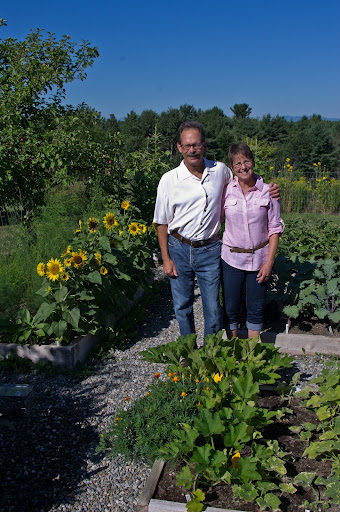
Sophia and Lily visited Lori and Doug's garden this week to take some pictures and get an update on how all those plants are doing in their new raised beds. The garden looks beautiful, and Lori and Doug, gracious as ever, are so pleased with their abundant harvests. A few lessons have been learned along the way in this garden's history, which you can read about here and here.
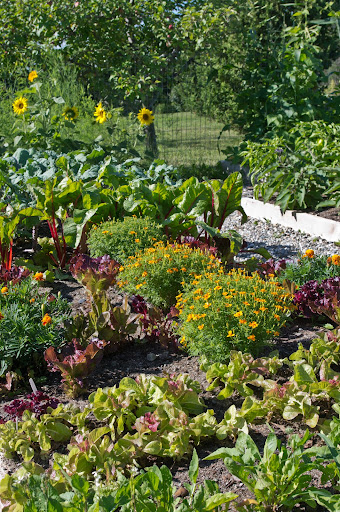
The garden is a great example of how colorful and varied a vegetable garden can be. Here an array of lettuces, marigolds, chard and kales co-mingle to create a carpet of textures, colors, and flavors. This is a perfect example of how edible gardens are also ornamental and can be featured in the center of a landscape.
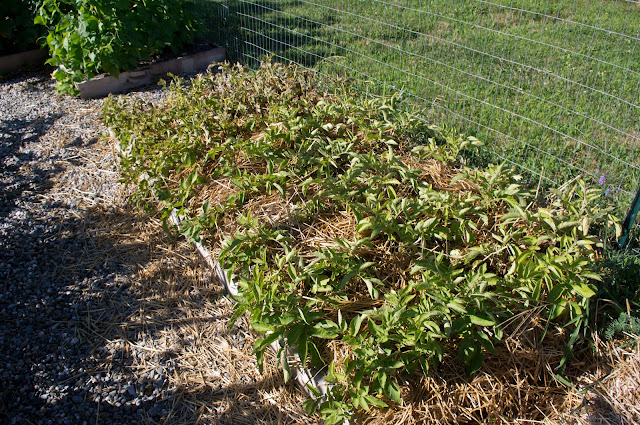
Doug and Lori did a tight spacing on their potatoes at planting time, so they decided to hill with straw since there was not enough room to hill the sides of the plants with soil. This should lead to good yields, helps retain moisture and keeps disease pressure down.

They carefully stripped the plants of blossoms in the spring and are awaiting next year's harvest. By taking off the blossoms in the first year, Lori and Doug were able to help the plants concentrate their efforts on producing the lush green growth you see in the picture. A raised bed is a great way to go with strawberries - it keeps the plants under control so that they do not spread into neighboring plants, the strawberry plants have better air circulation (therefore less disease) and it keeps the berries clean.

On a recent trip to Tuscany, Lori and Doug spied this trellising system and were able to re-create it at home. Anytime tomato plants are trellised from above, they will grow strong, tall and the fruit will be blemish free. This is the method used by greenhouse growers and in field production on small farms that really care about quality.
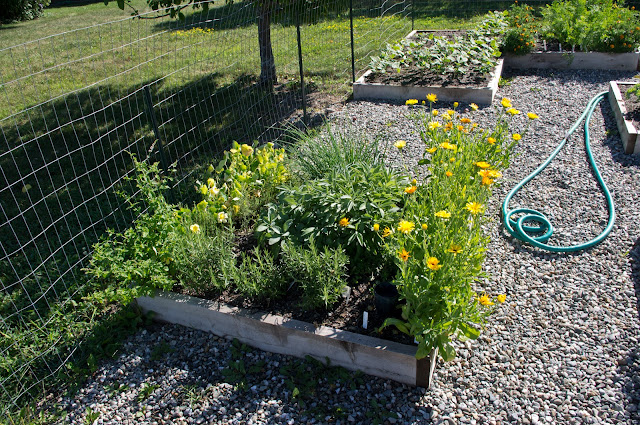
This small 4' x 4' bed provides plenty of space for herbs used daily in the kitchen as well as a few edible blossoms such as calendula. Lori makes a fantastic herb salt by very finely chopping sage or rosemary and mixing it with a good quality sea salt. This herb blend is great on hard boiled eggs, fish, salads, grilled meats.....pretty much anything you can think of. I felt pretty lucky when I was given a jar and have been carefully parsing it out ever since. It is also a great way to preserve herbs for winter use since the salt acts as a natural preservative.
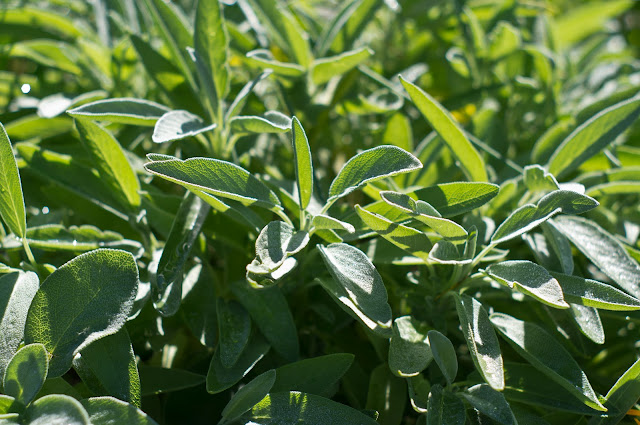
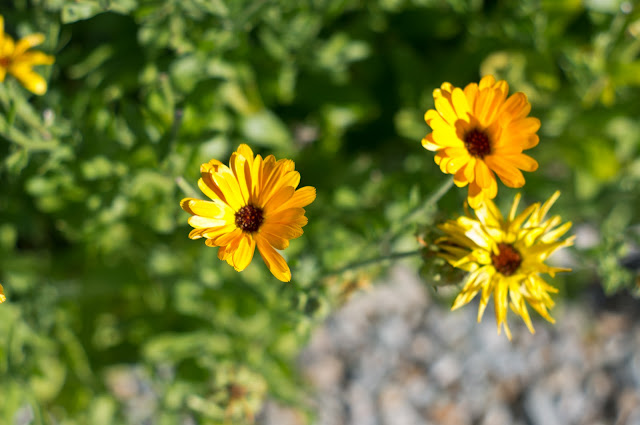


Spaces were cleared out as crops were harvested which meant that new plantings had plenty of room to grow. The space in the back corner is being reserved for another fall planting. Lori just called today saying that she is ready to do a round of fall crops - this will include lettuces, greens, cabbage, and some cold hard herbs such as parsley, cilantro, dill. It is always a good idea to clean up gardens regularly so that old or sickly plants don't take up space that could be used for new, fresh plantings.
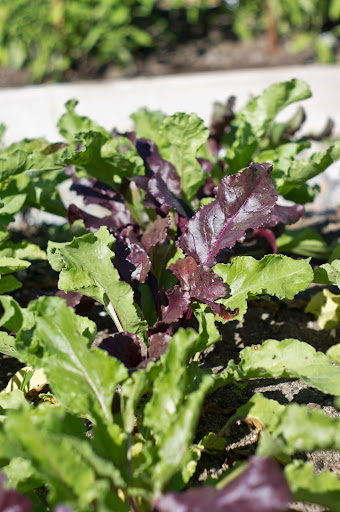
We just love the mixed beet plantings....the mixture of golden, cylindrical and regular beets makes for great salads.

These broccoli side shoots will keep producing into early winter. We only select varieties that produce lots of side shoots. Often one four pack is plenty to keep a small family in broccoli all summer, fall and early winter.
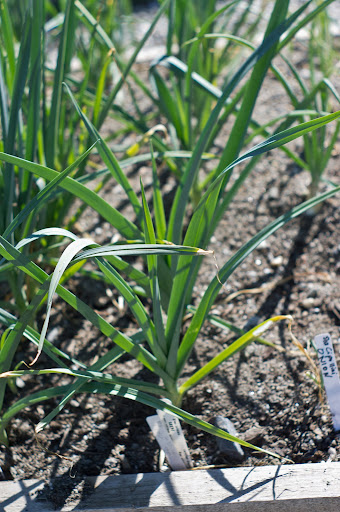

These peppers are great for stuffing. They have a wide, flat bottom and a large, hollow cavity. An herbed rice or a curried couscous is a lovely thing to pair with these beauties.

These are huge and lovely, and making me a bit jealous since the ones in my garden are small and not very happy.





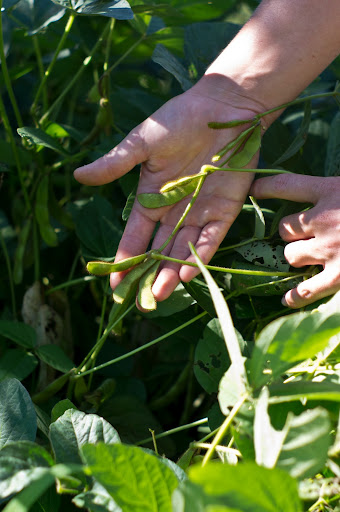
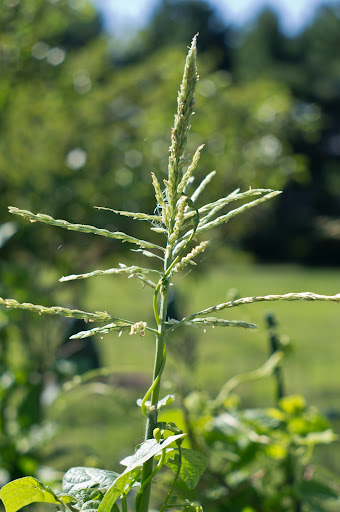
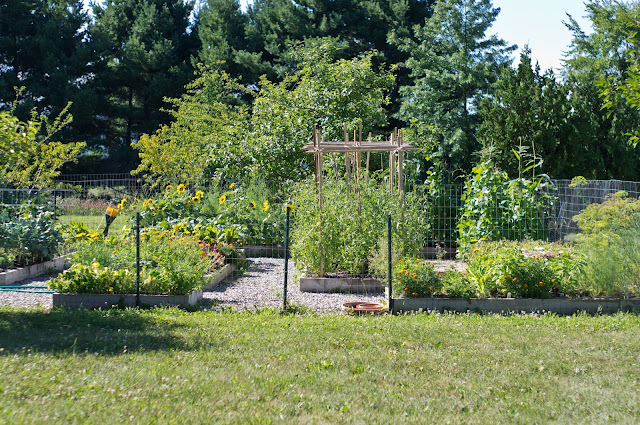
Before you start worrying about the fungal diseases that affect many garden crops this time of year, consider brewing up a batch of fermented compost tea. It is cheap, easy to make, and can protect your plants as well as help them out if they’re already suffering. Compost tea has been studied around the world and has been found to reduce fungal diseases by 50 to 90 percent. What do I mean by fungal diseases? These are diseases spread by spores (like microscopic seeds that germinate on leaf surfaces) and are encouraged by warm, wet conditions. This is why plants that have smooth or waxy leaves are less likely to be infected than plants that have textured or hairy leaves (which hold water). Common fungal diseases include:
While not fully understood, compost tea is believed to be beneficial for several reasons. Fermentation creates a healthy community of fungi and bacteria, which may outcompete fungal disease and help support a plant’s natural defenses. It also contains nutrients, which can be absorbed through foliage.
To make compost tea, mix one part mature compost that contains manure with five parts water. Allow the mixture to sit in a shady place for two weeks (it may become smelly!) Filter out large particles through cheesecloth, then spray on tops and bottoms of leaves every two weeks. The mixture will help reduce spreading of spores by infected plants, and can prevent infection of healthy plants.
- Adapted from The Gardener’s Guide to Plant Diseases, by Barbara Pleasant
There's been no shortage of excitement this week! The sweet potato slip sale was a great success (and we still have some left, if you missed out). Saturday was extra amazing because of the delicious treats whipped up by Jessica Bongard of Sweet Lime Cooking Studio...seriously, this girl rocks, and if you haven't checked out her cooking classes, you should! We're also having a sale: hanging baskets are buy one, get one 50% off, and shade perennials are buy one, get one free. So come get 'em before they're gone!


Meet Lori and Doug, two of our favorite long-time customers and friends. Our skillful and talented guy, Eric Denice, built them some beautiful raised beds and they've been busy planting. Check out what's sprouting in their garden. These photos are from a few weeks ago, and we are updating them as we find time....so stay tuned to see more of this great progress.

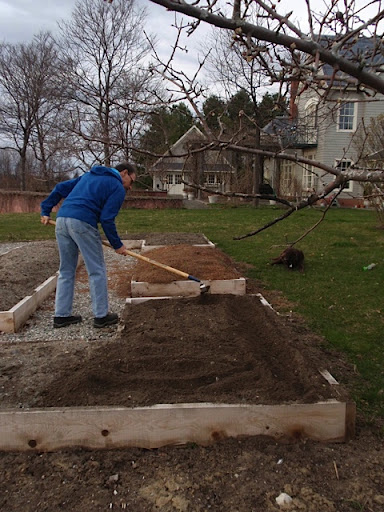





I think some incredible meals will be coming out of this garden and kitchen this summer. Keep checking in to see the changes!

Meet Lori and Doug, two of our longtime customers and friends. Last year, they visited the greenhouses repeatedly, making large purchases of vegetable plants, it seemed every day. I finally asked them if they were starting a small farm, and they admitted that they were having some problems. Apparently, everything kept turning black and dying. This does not usually happen to our plants, so I offered to visit their garden, which happens to be on the way home, and they happen to have very nice wine to offer, so it seemed like a win-win. Lo and behold, their beautiful garden site was also the low lying spot where their entire property drains. The plants were sitting in standing water (remember all the rain last year?) and were drowning. I advised them to just start over, sad as that is, because there was just no way to grow in that site.
They asked us to help them build a big beautiful raised bed garden, so we set our expert carpenter and all around handyman, Eric Denice, to the task. Here's what they created together.

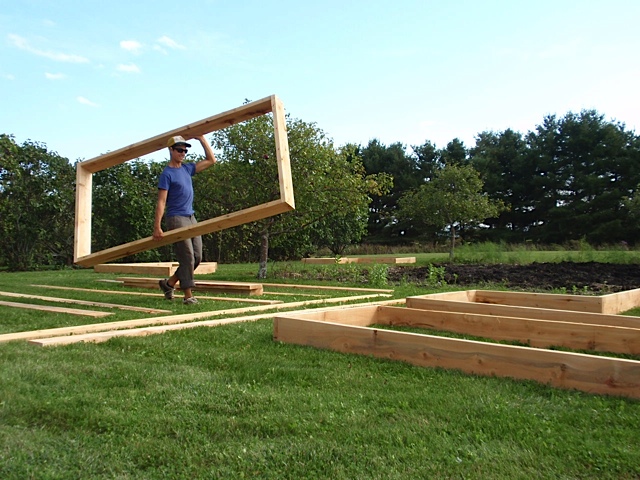
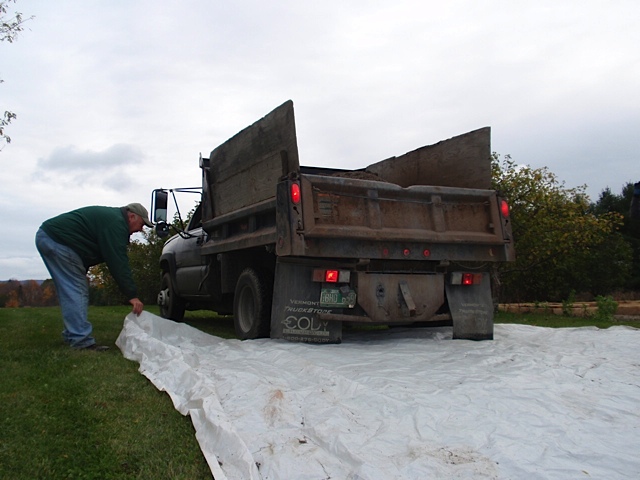
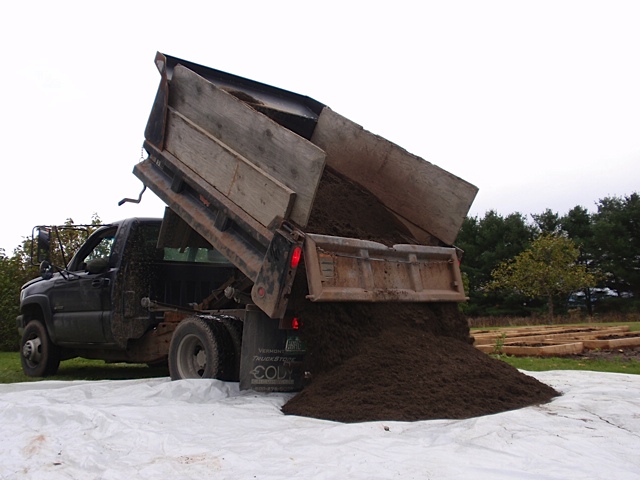
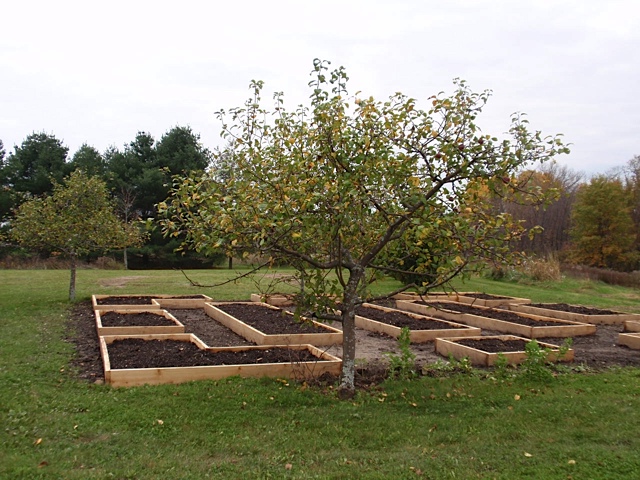

In the fall, Lori and Doug planted garlic, which is now growing beautifully, and each week, they come in to let us know what they are up to and we help them pick out plants that are appropriate for the weather. It has been such a fun project and we are grateful to Lori and Doug for including us!
Please keep checking back for updates as we chronicle the progress of this great garden and its people.

Given that our spring has been pretty mild over all, many gardeners are eager to get in the garden and plant a little earlier than normal. While the temptation is huge, it is also a good idea to remember that a hard frost can still come anytime in the next month or so and the ground is not all that warm. So what can go in the ground now? Lots of cold hardy vegetables and herbs are ready to go including onions, broccoli, cabbages, kales, mustards, boc choi, and more. It is best to harden off the plants for a few days before transplanting them - this means letting them get used to the cold, the wind, and the direct sunlight. Most of our plants will come to you already hardened off, but other nurseries may not take care to do that, so it is best to do it yourself. You can also use some row cover to create a small micro-climate for the young plants. We use hoops made out of 9-gauge wire to hold up the fabric off of the plants. This will give the plants a breathable, water permeable house to grow under during their initial weeks in the garden. The growth rate will be about double the rate of plants grown without row cover.
You can read more about hardening off here.
Another great thing to plant now are crops you direct seed and that can germinate in cold conditions - spinach, carrots, beets, turnips, radishes, scallions, peas, and fava beans.
If you have a spot in your garden that you are not going to use this year, you might want to consider spreading some cover crop seed. this will help ensure that the soil is fed during it's fallow period. The cover crop is essentially plants that are grown just for the soil's on going health. For cold weather sowing, you might want to try a cow pea and vetch mixture or oats or an annual clover . This will smother out weeds and add lots of organic matter to your garden.
From Lily: Gardening has been a constant in my life for as long as I can remember. And with one constant seems to come another… Garden Critters.
We all have our stories. The deer strolled though and ate the tops off all the baby beets. The woodchucks chomped cabbage heads in half. The neighbor’s horse got loose and stampeded the entire garden. Rascally raccoons destroyed the corn crop in the night. The squirrels had family feast in the blueberry bushes. Robins pulled out every bean sprout as they emerged from the earth. I’m all for sharing the harvest, but come on. This past spring was the last straw. I watched my own dog eat the asparagus shoots right out of the ground!
It was time to build a fence.
To install my own fence seemed like an unappealing and daunting project. I was intimidated. I like freedom, ease, and of course beauty in the veggie garden. Alas, I had to make moves. Precious asparagus was being robbed. There was no time to waste. Honestly, the dog was the main motivator. My biggest worry was that my quickie fence would be an eyesore. The final product has turned out to be nothing of the sort.
My garden comrades and I made construction choices with installation time, simplicity, and expense in mind. We decided on very basic materials that were easy to procure. Cedar posts for the corners and the entrance; installed with a borrowed posthole digger. Wooden grade stakes as the perimeter; one every 5-ish feet, pounded in with a mallet. Coated wire fencing with small holes at the bottom to keep out little critters and large holes at the top which is eye pleasing. We paid a little extra for this but I’m glad because the design is truly easy on the eyes (visually I’m not a fan of chicken wire). A staple gun came in handy to attach the fencing to the grade stakes. Lastly, a very simple wooden frame was constructed with the fencing material as the gate.
The fence has given the garden a sense of place and boundaries. It is no longer just a plot plowed out of the lawn. There is now a container to hold all the ideas, inspirations, and plans for the garden. In only a few hours we transformed the space! This year I hope to incorporate the fence more into the planting scheme of the garden by creating a narrow bed along the edge. The fence is a built in trellis. Why not plant annual climbing flowers! My favorites of course: Sweet peas, Cobaea, and Painted Lady Runner Beans.
I’ve also been dreaming up a project to build a solid gate. A gate that is structurally sound and provides an identity to the garden. Entrances hold an opportunity to set a scene, create a mood, transition from one thing to another. They are the first impressions of a space. When you pass through a gate or doorway you have the chance to leave behind what you don’t need: a chance to step into the present.
Here's some inspiration for gates and fences…






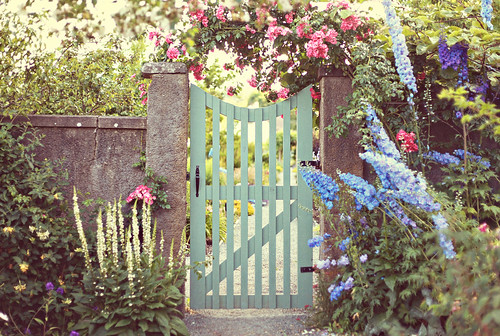


Sheet mulching is a technique for creating a garden bed that does not require tilling or hand weeding. It is intended to mimic the natural mulching process that occurs on the forest floor. It is also suitable for converting a section of lawn into a garden without breaking the sod. There are a lot of different methods but here is the simplest one:
Plants can be transplanted directly into this bed and should be closely spaced to minimize the germination of weeds. Note: this method is not recommended for areas that are prone to flooding or waterlogging. Graphic courtesy of agroforestry.net


The trick to having fresh lettuce all summer is to choose your varieties and timing well. You will need to have a succession of different varieties planted every week or so throughout the summer to ensure a constant supply. Start with cold tolerant varieties in the spring, then plant heat- and drought-tolerant ones in the summer, and plants with good holding ability and heat tolerance in late summer and early fall. Plants turn bitter when they are starting to bolt (go to seed) and are exposed to too much heat, so choosing your variety and timing well also avoids bitterness. Here’s an example planting:
Perennials: Angelica, Catnip, Chives and Garlic Chives, French Sorrel, Germander, Anise Hyssop, ‘Munstead’, 'Grosso', 'Provence' Lavender, Lemon Balm, Lovage, Mint, Oregano, Rue, Sage, Winter Savory, Sweet Woodruff, French Tarragon, Thyme, Valerian Annuals: Artemisia (self seeds), Basil, Chamomile (self seeds), Chervil (self seeds), Cilantro, Dill, Fennel, Feverfew (self seeds), Lemongrass, Marjoram, Papalo, Parsley, Red Shiso, Rosemary, Summer Savory
Some herbs can be kept as houseplants over the winter. Some that do well are rosemary, thyme, sage, basil, and parsley. It is always nice to have a few pots of these in the kitchen to snip into bowls of soup, salads, scrambled eggs and roasted vegetables and meats. You can dig them up out of the garden in the fall or just grow them in pots all summer that you then bring into the house once the temperature drops.

The first step to preventing bolting is to understand what causes it. Bolting, or going to seed, is a natural part of the plant's life cycle. Some plants have longer life cycles than others. Arugula, lettuce, cilantro and dill all have relatively short life cycles, so they will try to produce seed within 8 to 10 weeks of being planted. It is an inevitable part of the plant life cycle but can be postponed with good management. It can also be caused by shock during transplanting, by too much or too little water, and around the solstice when the days start getting shorter. Transplant shock can be minimized by careful hardening off and transplanting in late afternoon when the plants will not be exposed to intense midday heat. Water carefully and time your plantings so that a fresh generation is coming along before the previous generation goes to seed. Here is a helpful schedule to help you maximize the harvest:
Cilantro - plant every 3 weeks from late April to mid August. These are very cold tolerant and can be grown early and late to extend the season. If you are very eager to have cilantro for salsa, then make sure to plant some in early July so that it is ready to eat at the same time as your tomatoes are ripe. The flowers of cilantro are edible and are a lovely addition to salads and salsas.
Dill - like cilantro, is very cold tolerant and can be grown early and late in the season. This self seeds willingly, so you can always allow a patch to flower and drop its seeds giving you a perpetual patch. The flowers of dill are tasty in pickles and marinades.
Lettuce - lettuce can be grown at the baby leaf stage or the full head stage. Please refer to our lettuce post to learn more about the timing of lettuce. It should be planted every week or two if you eat lots of salads and want fresh, non-bitter leaves on your plate. It can be planted from seeds or from plants. If you prefer the texture and flavor of full heads of lettuce, then transplant individual plants every 10" - about 4 to 8 transplants a week is plenty. If you prefer cut lettuce leaves, then use seeds, and sprinkle them in a row, about 2 or 3 seeds per inch. Cut lettuce leaves can grow back and provide you with a second harvest, but the quality goes down each time and the bitterness increases. It is best to replant a fresh row of seeds every couple of weeks.
Arugula - like lettuce, it can be grown from transplants or from seeds. It is best to plant it regularly as it does not grow back very well. Its flowers are edible, and can be a nice peppery additions to salads, sauces, and grilled fish.
Red Wagon grows a number of plants that make good houseplants. The characteristics to look for are a tolerance of shade, a preference for hot conditions (such as tropical plants), and plants that are annuals (do not require cold winters). Some great choices are:

First you need to determine if you have full sun, partial sun, or full shade in the area you are considering. The best way to do this is to spend a day (with a clear sky) at home and note which areas come into sun and when, and when they are in shade again. Do this in spring when you have a realistic amount of sunlight, not in summer when the day is longest.
Full sun means at least 6, but preferably 8 hours of direct sun each day. Sun loving plants can usually survive with less but will not bloom as much.
Part sun and part shade plants prefer 3-6 hours of direct sunlight per day; however part sun plants can usually take more heat than part shade plants, which will want relief from strong afternoon sun.
Full shade means zero to 3 hours of direct sunlight. These plants do NOT want total darkness but rather filtered, or indirect light, such as that provided by a deciduous forest.
From Sophia: Powdery mildew is a white powder-like fungus that particularly grows on cucurbits such as cucumbers and squash, French tarragon, bee balm, and other plants under adverse conditions. Powdery mildew does not generally kill the plants but will reduce their productivity and vigor. You can help prevent the disease by giving plants plenty of air circulation, only watering in the morning when the plants have time to dry, not planting cucurbits in the same place two years in a row, and destroying insect pests when you find them.

Once you have powdery mildew, you can manage it by removing the worst affected leaves with pruners. DO NOT put the leaves in your compost pile! Either burn them or throw them in the trash. Wash hands and tools with soapy water or dilute bleach solution after handling affected foliage and before touching other plants. Plants can be sprayed with a copper- or sulphur-based organic fungicide, or with a mixture of 1 teaspoon baking soda to 1 quart of water, once per week on the upper and undersides of the leaves until 2 weeks before harvest. This should eliminate the disease.
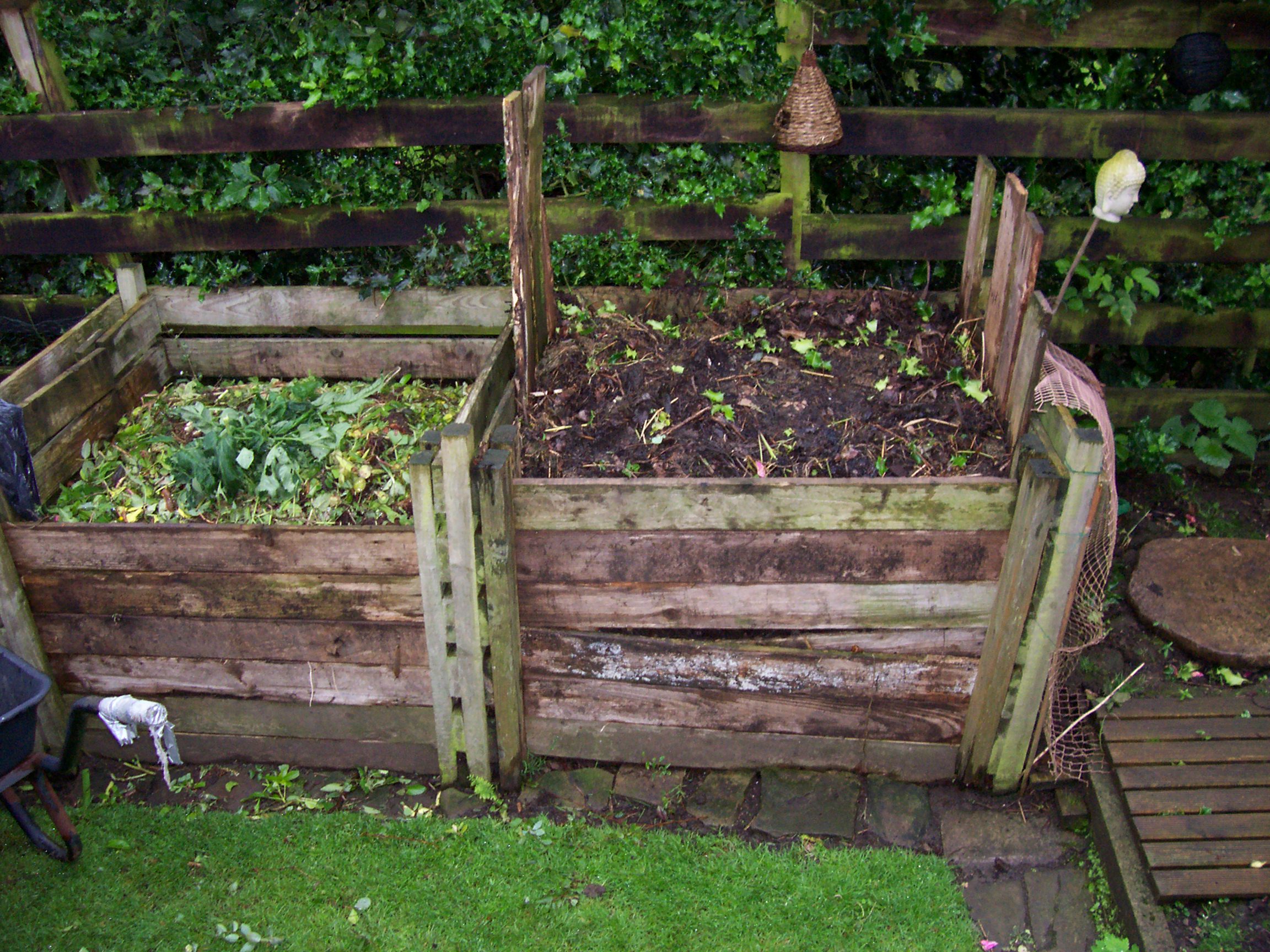
Make some kind of container about 3’ in diameter, such as a length of chicken wire or 4 pallets hitched together to make a square. Put a layer of sticks on the bottom, just thrown in to allow air to flow into the pile. Add a variety of plant material, in layers if you can, but it’s not really necessary. You need some brown material, such as leaves, and some green material, like freshly pulled weeds, grass clippings or kitchen scraps. Top with a few handfuls of manure, if you have it, or half-done compost. This isn’t necessary, but speeds up the process. Sprinkle with water so the pile feels like a damp sponge. Don’t soak it, it needs air. The pile should heat up. When it stops, turn it. A compost aerator makes turning the pile an easy matter, so I do it more often, but you can also use a shovel or garden fork. Having two compost piles makes it easier to use the finished compost, since one can be allowed to finish while you’re adding to the other. Use the finished compost on your garden. Even if it’s not be finely screened compost, it will finish decomposing in the soil.
It depends on what you want! Annuals have to be planted each year because they are tender and don’t overwinter in VT, so you have to buy new ones each season. However, once they start blooming, they do so all summer, if you take good care of them. At the end of the summer just pull them out and throw them in the compost pile.
Perennials are long lived, often indefinitely, but only bloom for a part of the season. In order to have color all season, you need to plant a wide variety of plants. Some need to be cut down after blooming and you may have an empty spot in your garden. Most perennials need dividing in order to be at their best and not look scraggly or take over the garden. Often a mix of annuals and perennials works well to ensure constant color in the garden. Biennials are plants that live for two years but behave somewhat like perennials because they flower and self-seed in their second year, and the seedlings will return year after year. Hollyhocks are a good example.
Virtually all plants will bloom longer if you deadhead them. Picking lots of blossoms encourages the plant to branch and so you get more. I’ve had especially good luck with these varieties: Heliopsis (False Sunflower), which sometimes blossoms for 10-12 weeks in the fall Rudbeckia (Black Eyed Susan) – 6-7 weeks Monarda (Bee Balm) - 8-12 weeks Coreopsis - 8-12 weeks Bleeding Heart (Dicentra) ‘Luxuriant’ - 10-14 weeks, Feverfew – 8-12 weeks if you let new plants grow and cut back the old ones
